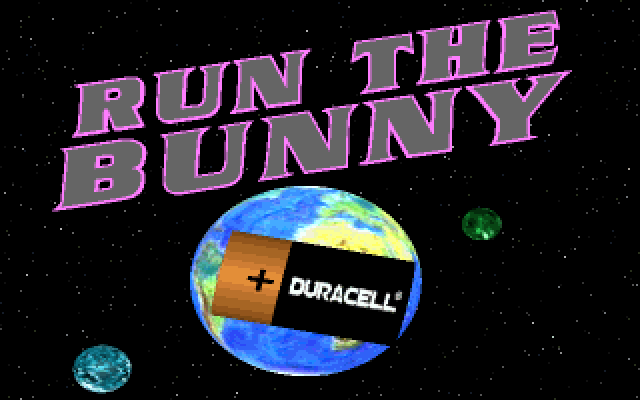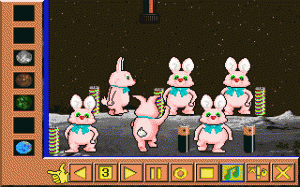Duracell: Run the Bunny 
It’s understandable that Duracell would produce a game based on their mascot character. I don’t understand what Duracell: Run The Bunny was supposed to be, though. It’s barely coherent as a game, as an advertisement, or as anything. Duracell probably didn’t expect this either.
UPDATE: New unsettling information about Run the Bunny, straight from the developer’s mouth.
In Run the Bunny, you play as the Duracell mascot bunny, the original drumming battery rabbit that eventually lost its trademark to Energizer. Your goal is to collect Duracell batteries, which allow you to proceed through a number of levels. The bunny moves around in a Wolfenstein-esque pseudo-3D maze, looking for the exit and whatever other items come his way, such as hatpins that pop balloons. Or drumsticks, which do nothing. Or the Duracell drum, another seemingly important item that also can’t be used. The game insists that you must deliver the drum and drumsticks to another bunny in the stage, but that bunny is either missing or already drumming away by the time you show up. Come to think of it, the batteries – the most important objects in the game – can be avoided too. Essentially, every objective the game asks you to perform is optional. Most of the items serve no function whatsoever and disappear between levels.
You might question their inclusion, but you’d be too distracted by the random objects placed in each stage. Run the Bunny includes a light puzzle element, in that touching one part of the level will cause another section to change in some way. Rather than fall for the standard “put the key in the door” trap, the good folks at Adware Interactive (really) went for illogical image association. For example, touching clowns will open a wall, as will ducks. Right? Even the in-game help file gives up, simply stating that “Depending on where you are in the game different things will happen.” Other environmental interactions include sliding RC cars into panes of glass or collecting bunnies that disappear on contact with no visible effect.
The game drops this shtick about halfway through and turns into a series of animated vignettes featuring pink bunnies weightlifting and playing musical instruments. Things start drifting into incomprehensibility at this point. The interface makes progressively less sense, with bizarre loading screens featuring the Duracell bunny kayaking through space and a display of what appears to be multicolored planets, one more added for each stage completed. The player’s movement will abruptly stop when touching a wall, even when slightly grazing it from the side. One section takes place in complete darkness. Some levels border on uncompletable. A navigation bar at the bottom lets you jump between the stages and weird animated segments at will, but despite these handicaps for the sake of making the promotional game more accessible to novices, the ending remains locked until you complete every other part.
Apart from a brief but skippable menu screen, absolutely nothing in Run the Bunny gets so much as even a word attached to it. The planets are never mentioned, nor does the game attempt any kind of cohesive explanation for what’s going on in the levels. Advergames exist only to establish some kind of loyalty, awareness, or connection between a broad audience and your brand. But when the game consists mostly of bunnies gliding around space in total silence, trying to push a clown into a wall, that’s not happening.
The best part? By the game’s release in 1996, the Duracell Bunny had been entirely phased out in the company’s American ad campaign.
UPDATE: I recently had an email exchange with Mel Croucher, the CEO of Adware Interactive, about Run the Bunny. The truth is shocking but somehow unsurprising.
Players who completed Run the Bunny were presented with a sweepstakes screen where they could win battery-powered devices big and small. By inputting their email address, winners also submitted their gameplay history. Those weird, optional random objects and interactive sequences? They were purposely constructed to figure out players’ lifestyle preferences for directed email marketing. Anyone entering the sweepstakes also had the option to email the game to a friend, with the catch that they would receive copies of any prizes the referrer won. And of course, their emails entered an advertising database too. The game also included a huge variety of languages to broaden the player base.
The result? Run the Bunny was a massive, orchestrated attempt to create an email advertising network for Duracell. It’s brilliant, but scary. According to Croucher, Duracell reached triple its initial estimates, all from players “shoving virtual batteries into virtual pink bunnies.”
Though you have to wonder, how did people have the patience to play to the end of that?


